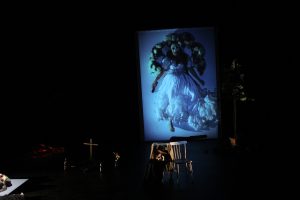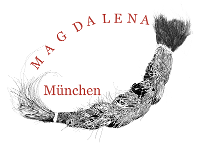Frauen-Theater-Performance
Rosa un retrato de América Latina
- 06.04., 19:00 HochX
Rosa – ein Portrait aus Lateinamerika
“In diesem Stück teile ich den Gesang einer Generation von Töchtern und Frauen, die nicht länger erniedrigt werden woollen. Wir werden Inspirationen von großen lateinamerikanischen Künstlerinnen nutzen, um die Transformation von harscher Realität in explosive und lebensrettende Kunstwerke zu zeigen.”
Rosa nutzt die evokative und metaphorische Kraft von Musik und Video und zeichnet damit das Portrait einer lateinamerikanischen Frau, einer Figur aus einem Gemälde von Débora Arango oder Frida Kahlo, einer Stimme, die sich wütend erhebt wie ein Lied von Violeta Parra. Ans Haus gefesselt oder von neoliberalen Umständen ausgebeutet, in ihrem Begehren zensiert und manchmal ins Exil getrieben, überlebt Rosa in einem Land, das zwischen den Versprechungen der Emanzipation und der Gewalt eines von den USA implementierten Gesellschaftsmodells navigiert.
Das Schauspiel porträtiert verschiedene Momente aus Rosas Leben; durch den Gebrauch von Live-Kameras und sich vervielfältigenden Bildern wird der Raum verändert, um sowohl von ihrem intimen Leben als auch von unserer kollektiven Erinnerung zu erzählen. Die Werke und Leben von Frida Kahlo, Violeta Parra, Debora Arango und Rigoberta Menchú haben die Autorin dazu inspiriert, Charaktere zu schaffen, die historische Fakten illustrieren, alltägliche Situationen verkörpern und schwere Themen wie Kolonisierung, Indigenität, Kapitalismus und soziale Unterdrückung konkret angehen. Das Stück ist ebenso von anonymen Frauen inspiriert, von unseren Müttern und Großmüttern, die alle irgendwann in ihrem Leben mit Verachtung, Gewalt und der Unterdrückung ihrer Wünsche konfrontiert waren. Durch ihre Stimmen entdecken wir eine tiefe und empfindsame imaginäre Welt, die uns auf dem einen wie dem anderen Kontinent unsere Zeit begreifen lässt. Viele von uns sind heute noch Opfer sexisitischer Gewalt. Es ist noch ein langer Weg zu gehen bis zu einer wirklichen Gleichheit von Mann und Frau.
Der Soundtrack erkundet wie im Kino ein weites Feld von Emotionen und lässt die Erzählung kulminieren. Die Lieder vervollständigen diese Klanglandschaft, um die Träume und Kämpfe lateinamerikanischer Frauen hervorzuheben, die in der Geschichte oft auch aus sozialen Bewegungen ausgegrenzt waren.
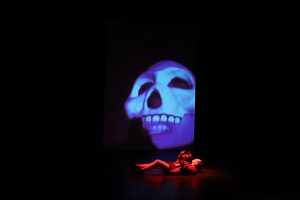 Rosa a Portrait of Latin America
Rosa a Portrait of Latin America
“In this show, I bear the song of a generation of daughters and women who no longer want to be humiliated. We will get our inspiration from great Latin American artists to show the transformation of harsh reality into explosive and lifesaving artworks.”
Relying on the evocative and metaphorical strength of music and video, Rosa is the portrait of a Latino-American woman, a character out of a painting from Débora Arango or Frida Kahlo, a voice that rises with rage like a song from Violeta Parra. Confined to the shackles of home or enslaved by neoliberalism codes, censored in her desires and sometimes driven to exile, Rosa survives in a country that navigates between the promises of emancipation and the violence of a social model imposed by the United States.
The play portrays different moments of Rosa’s life; using live cameras and proliferating images, the space is transformed in order to talk about her intimate life and our collective memory. The works and lives of Frida Kahlo, Violeta Parra, Debora Arango et Rigoberta Menchú inspired the creation of characters to illustrate historical facts, embody daily situations and concretely tackle strong themes like colonisation, indigenousness, capitalism and social oppression. The play is also inspired by anonymous women, by our mothers and grandmothers who all, at one point in their lives, have had to face contempt, violence, the supression of their desires. Through their voices, we discover a deep and sensitive imaginary world to decipher our time, from one continent to the next. Many of us are still victims of sexist violence. There is still a long way to go to achieve a true equality between men and women.
The soundtrack explores a vast range of emotions which, as it does at the cinema, brings narrative to its culminations. The songs complete this soundscape to bring to the fore the dreams and struggles of Latino-American women, who were historically sidelined from the social movement.
Mit freundliche Unterstützung des Migrationsbeirats.
Feministischer Aktivismus als Performance
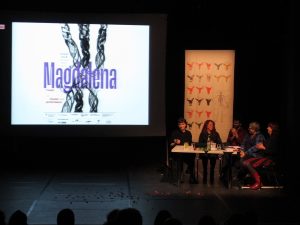 06.03., 19:00, HochX
06.03., 19:00, HochX- in Kooperation mit Welt Frauen Tag
Wie wird Performance als Werkzeug für feministischen Aktivismus genutzt? Wie setzen feministische Aktivistinnen Performance ein und wie drücken Performancekünstlerinnen feministischen Aktivismus durch ihre Arbeit aus? Dieser Abend der Performances, Vorträge und Diskussion ist der kürzlich verstorbenen Performancekünstlerin und Gender-Aktivistin Diane Torr gewidmet .
Eröffnet wird der Abend von der Performance Tapete Manifesto, dem Höhepunkt eines viertägigen körperorientierten Theaterworkshops von Thaís Medeiros, Performancekünstlerin aus Brasilien. Die Workshop-Teilnehmerinnen werden das Thema Gewalt gegen Frauen in Brasilien und Deutschland erforscht und eine physische Dramaturgie entwickelt haben, um das Thema zum Ausdruck zu bringen.
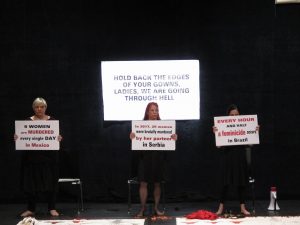 Die lesbische feministische Kunstaktivistin und Performerin Zoe Gudović aus Serbien und Thaís Medeiros werden anschließend ihre Arbeit diskutieren und die aktuelle Situation des feministischen Aktivismus in ihren Heimatländern vorstellen.
Die lesbische feministische Kunstaktivistin und Performerin Zoe Gudović aus Serbien und Thaís Medeiros werden anschließend ihre Arbeit diskutieren und die aktuelle Situation des feministischen Aktivismus in ihren Heimatländern vorstellen.
Moderatorin: Maria Fedorova
Diane Torr (1948-2017) war eine Performancekünstlerin, die internationale Anerkennung fand mit der Verkörperung von Männern, ihrer Figur des “Drag-King” und „Mann für einen Tag“-Workshops, performative Forschung an dem Phänomen Gender. Torrs Arbeit untersuchte sehr genau die Verhaltenskodizes, Gestik, Körpersprache und Bewegung, die die Performance der Männlichkeit begründen. Ihre Arbeit wurde in dem Film Man for a Day (2012) von der deutschen Regisseurin Katarina Peters dokumentiert.
Maria Fedorova ist eine Journalistin aus der Ukraine und wohnt seit 2011 in München. Sie hat romanische und germanische Philologie an der Nationalen Universität Donezk und Politik und Kommunikationswissenschaft an der LMU München studiert. Seit 2016 ist sie Autorin und Reporterin für die Radiosendung Zündfunk des Bayerischen Rundfunks. Als Journalistin beschäftigt sie sich primär mit den Themen Feminismus, Pop-Kultur und politische Bewegungen.
Feminist Activism as Performance
- Tuesday 6 March, 7:00pm, HochX
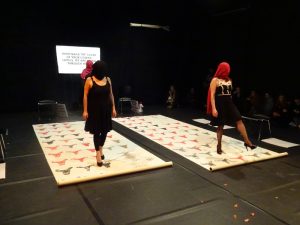 How is performance used as a tool for feminist activism? How do feminist activists employ performance, and how do performance artists express feminist activism through their work? This evening of performance, lectures and discussion is dedicated to the late Diane Torr, performance artist and gender activist.
How is performance used as a tool for feminist activism? How do feminist activists employ performance, and how do performance artists express feminist activism through their work? This evening of performance, lectures and discussion is dedicated to the late Diane Torr, performance artist and gender activist.
The evening will open with the performance Tapete Manifesto, the culmination of a four day physical theatre workshop led by Thaís Medeiros, performance artist from Brazil. Workshop participants will have undertaken research around the theme of violence against women in Brazil and in Germany, and developed a physical dramaturgy through which the theme is expressed.
Zoe Gudović, lesbian feminist artactivist and performer from Serbia, and Thaís Medeiros will discuss their work and present the situation of feminist activism in their own countries.
Moderator: Maria Fedorova
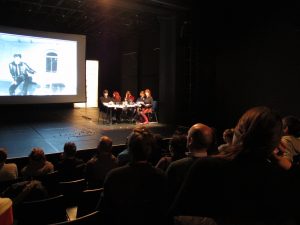 Diane Torr (1948-2017) was a performance artist who became internationally recognised for her male impersonations and “Man for a Day” workshops, which explored gender as performance. Torr’s work closely examined the codes of behaviour, gesture, body language and movement that constitute the performance of masculinity. Her work has been documented in the film Man for a Day, directed by German film director Katarina Peters (2012).
Diane Torr (1948-2017) was a performance artist who became internationally recognised for her male impersonations and “Man for a Day” workshops, which explored gender as performance. Torr’s work closely examined the codes of behaviour, gesture, body language and movement that constitute the performance of masculinity. Her work has been documented in the film Man for a Day, directed by German film director Katarina Peters (2012).
Maria Fedorova is a journalist from Ukraine, based in Munich since 2011. She has a degree in romance-germanic philology from the National University Donezk and a degree in political science and communication studies from the Ludwig Maximilian University of Munich. Since 2016 she is working as an author and reporter for the radio program Zündfunk/Bavarian Broadcasting. She primarily writes about feminism, pop-culture & politics.
Raquel Ro
- 07.04 Presentation: Voz Láctea– Magdalena Tarahumara, HochX.

http://cargocollective.com/RaquelRO
Raquel RO ist Mutter und Künstlerin, die sowohl mit Installationen als auch performativen künstlerischen Herangehensweisen arbeitet. Zusätzlich befasst sie sich mit der Herstellung von künstlerisch angelegten Büchern und graphischen Techniken. Sie arbeitet für und über die Anerkennung eines weiblichen Wissens. So arbeitet Raquel mit Texten und Ausdrucksformen von Frauen der Gegenwart und der unmittelbaren Vergangenheit. In ihren Arbeiten baut die Künstlerin ein reflexives Miteinander und Mitgefühl mit dem Publikum auf.
Raquel Ro wurde in Mexiko gezeugt und 1981 in Barcelona geboren. Einem Diplom an der Universität de Barcelona 2008 folgte ein einjähriges Studium in bildender Kunst an der Universität der Künste Mexiko E.N.A.P. Ein Erasmusstipendium ermöglichte ein Studium bei Matthias Wähner an der Kunstakademie München. 2009 gründete sie die Druckwerkstatt „dreiUNdreizig“. Nachdem sie sich 2015 bei Magdalena München engagiert hat, hat sie sich auch der Organisation für Magdalena Tarahumara angeschlossen, ein Magdalena-Festival (Mai 2018, Mexiko). Raquel lebt und arbeitet in München.
Raquel RO is a mother and artist who works with both installations and performative artistic approaches. She is also engaged in the production of artistic books and graphic techniques. She works for and about the appreciation of female knowledge, using texts and expressions of women of the present and the immediate past. In her work, Raquel builds a reflexive coexistence and compassion with the audience.
Raquel Ro was concieved in Mexico and born in Barcelona in 1981. A diploma at the University of Barcelona 2008 was followed by a one-year course in fine arts at the University of Arts Mexico E.N.A.P. An Erasmusstipendium enabled her to study with Matthias Wähner at the Kunstakademie München. In 2009 she founded the printing workshop “dreiUNdreizig“. After participating in Magdalena Munich in 2015, she joined the organisation for Magdalena Tarahumara, a Magdalena festival to be held in Mexico in May 2018. Raquel lives and works in Munich.
Moje Holka, Moje Holka
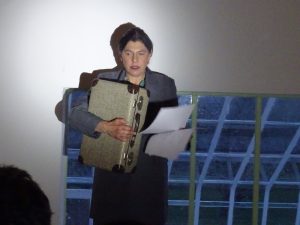 Foto Galerie
Foto Galerie- 12.04, 19:30: inszenierte Lesung, Villa Waldberta. Eintritt frei.
Moje Holka, Moje Holka (Mein Mädchen, mein geliebtes Mädchen) ist von der Geschichte von Nava Schan (auch unter dem Namen Vava oder Vlasta Schönova bekannt) inspiriert. Nava Schan war eine tschechische Schauspielerin jüdischen Ursprungs, die im Jahr 1942 ins Konzentrationslager Theresienstadt gebracht wurde. Dort kreiierte sie mit und für Kinder Theaterproduktionen.
A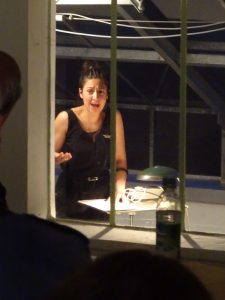 maranta Osorio und der spanische Autor Itziar Pascual haben dieses Theaterstück gemeinsam geschrieben.
maranta Osorio und der spanische Autor Itziar Pascual haben dieses Theaterstück gemeinsam geschrieben.
In dem Stück geht es um den Holocaust und um die Stärke der Frauen und es geht um Licht und Hoffnung.
Im Jahr 2016 gewann das Manuskript den spanischen Preis “Premio de textos teatrales Jesús Dominguez”. Darüberhinaus bekam das Stück eine Förderung von der spanischen Autorengesellschaft, damit es von spanisch in die französische Sprache übersetzt werden kann. Die Women Playwrights International Conference hat das Manuskript für ihre Konferenz im Jahr 2018 in Chile ausgewählt. Moje Holka, Moje Holka ist dem Magdalena Projekt gewidmet.
Die Magdalena Saison 2018 präsentiertiert das Theaterstück Moje Holka, Moje Holka als Lesung, die von Sabine Bollenbach und Mira Mazumdar dargeboten wird. Regie führt Kordula Lobeck de Fabris. Die deutsche Übersetzung stammt von Stefanie Gerhold.
Moje Holka, Moje Holka
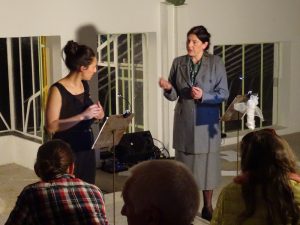 Moje Holka, Moje Holka (My girl, my beloved girl) is inspired by the story of Nava Schan (also known as Vava or Vlasta Schönova), a Czech Jewish actress who was deported to the Terezin concentration camp in 1942. There, she created theatre productions for and with the children in the camp.
Moje Holka, Moje Holka (My girl, my beloved girl) is inspired by the story of Nava Schan (also known as Vava or Vlasta Schönova), a Czech Jewish actress who was deported to the Terezin concentration camp in 1942. There, she created theatre productions for and with the children in the camp.
Co-written by Amaranta Osorio and the Spanish author Itziar Pascual, the play talks about the Holocaust, the strength of women, and about light and hope.
In 2016 the script won the Spanish prize Premio de textos teatrales Jesús Domínguez, was selected for the readings of the Authors’ Society (Spain) with a grant for translation into French, and was selected for the Women Playwrights International Conference that will take place in Chile in 2018. Moje Holka, Moje Holka is dedicated to the Magdalena Project.
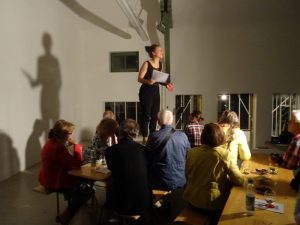 At the Magdalena München Saison 2018, a rehearsed reading of Moje Holke, Moje Holke will be presented, directed by Kordula Lobeck de Fabris and performed by Sabine Bollenbach and Mira Mazumdar; German translation by Stefanie Gerhold.
At the Magdalena München Saison 2018, a rehearsed reading of Moje Holke, Moje Holke will be presented, directed by Kordula Lobeck de Fabris and performed by Sabine Bollenbach and Mira Mazumdar; German translation by Stefanie Gerhold.

Amaranta Osorio
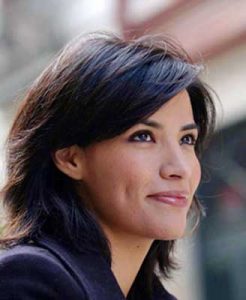 Lesung / Reading: Moje Holka, Moje Holka
Lesung / Reading: Moje Holka, Moje Holka- Foto Galerie
Amaranta Osario ist Autorin, Schauspielerin und Kulturmanagerin. Sie absolvierte ihren Master für Kulturmanagement an der Complutense Universität Madrid und machte ihren Abschluss in Dramaturgie an der RESAD ( Royal School of Dramatic Arts of Madrid ).
Sie inszenierte zahlreiche Theaterstücke in Spanien und Latein Amerika. Mit dem Kurzfilm Inseparables gewann sie den Express Theater Preis der Caja Madrid und den Jesús Domínguez Preis für Theatertexte. Karriere machte Amaranta als Schauspielerin und Festival Intendantin. Sie ist aktives Mitglied des Magdalena Projekts und Mitglied der Vereinigung „Clasicas y Modernas“.
Amaranta präsentiert eine szenische Lesung Ihres Stückes Moje Holka, Moje Holka, das sie in Zusammenarbeit mit Itziar Pascual geschrieben hat. Die Übersetzung ins Deutsche ist von Stefanie Gerhold. Die Lesung wird inszeniert von Kordula Lobeck de Fabris und dargestellt von Sabine Bollenbach und Mira Mazumdar.
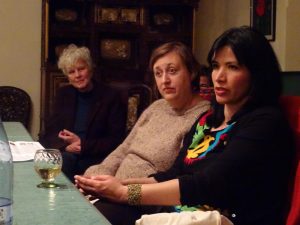 ITZIAR PASCUAL
ITZIAR PASCUAL
Itziar Pascual ist Dramatikerin, Pädagogin, Rechercheurin und Journalistin. Sie erlangte Ihren Doktor der Informationswissenschaft an der Complutense University von Madrid und machte den Abschluss in Dramaturgie an der RESAD (Royal School of Dramatic Arts of Madrid). Seit 1999 hat sie an der RESAD eine Professur für Dramaturgie inne. Sie ist Autorin von mehr als dreißig Publikationen, die in verschiedenen Sprachen und Ländern herausgegeben wurden. Dazu zählen u.a. „Variations on Rosa Parks“ and „Eudy“. Itziar ist Gründungsmitglied von AMAEM Marías Guerreras, einer Vereinigung für Frauen-Theater in Madrid.
More info in: http://www.contextoteatral.es/itziarpascual.html
STEFANIE GERHOLD
Stefanie Gerhold, 1967 geboren in München, studierte Violine und Romanische Philologie. Sie übersetzt seit zwanzig Jahren spanische und lateinamerikanische Literatur, mit Schwerpunkt Dramatik. Außerdem ist sie Autorin einiger Essays über transkulturelle Themen und eines Hörspiels, Come Back. Derzeit schreibt sie an einem Roman.
AMARANTA OSORIO
Amaranta Osorio is an author, actress and cultural manager. She holds a Master in Cultural Management from Complutense University of Madrid and a degree in dramaturgy by RESAD (Royal School of Dramatic Arts of Madrid). She has premiered several plays in Spain and Latin America. She received various prizes for the short film Inseparables, the Express Theater Prize of Caja Madrid and the Jesús Domínguez Prize for Theatrical Texts. Amaranta has an extensive career as an actress and festival director. She is member of the Magdalena Project and part of Clasicas y Modernas.
Amaranta will present a rehearsed reading of her play Moje Holka, Moje Holka, co-written with Itziar Pascual and translated into German by Stefanie Gerhold. The reading will be directed by Kordula Lobeck de Fabris, and performed by Sabine Bollenbach and Mira Mazumdar.
ITZIAR PASCUAL
Itziar Pascual is a playwright, pedagogue, researcher and journalist. She holds a Doctorate of Information Science from the Complutense University of Madrid and has a degree in Dramaturgy from the RESAD (Royal School of Dramatic Arts of Madrid). She has been professor of Dramaturgy at RESAD since 1999. She is the author of more than thirty published works, which have been translated and released in several countries, including Variations on Rosa Parks and Eudy.
She is a founding member of AMAEM Marías Guerreras, a women’s theater association in Madrid.
More info in: http://www.contextoteatral.es/itziarpascual.html
STEFANIE GERHOLD
Stefanie Gerhold was born in Munich in 1967 and studied violin and Romance philology. She has been a translator of Spanish and Latin American literature for 20 years, with a clear preference for drama. She has also written essays on transcultural themes and a radio play, Come Back. Currently she is writing a novel.

Tale 53: Snowhite
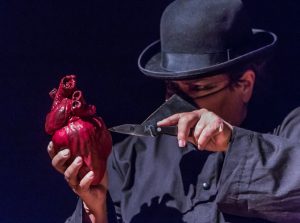
- 02.& 03.02., HochX
- 24.02., Meta Theater (Moosach bei Grafing)
Tale 53; Snowhite
Tale 53; Snowhite ist eine unheimliche Geschichte, die sich in einem faszinierenden hölzernen Bauwerk abspielt, das ein Puppentheater (mit zweidimensionalen, sich auf Gleisen bewegenden Puppen), Objekte, ein kamishibai (für Hintergrundwechsel) und ein “cranky”, sich bewegendes Panorama beherbergt. Es basiert auf Schneewittchen, einem Werk der bekannten spanischen Autorin und Illustratorin Ana Juan. Deborah Hunt hat die Geschichte adaptiert, führt Regie und spielt mit Puppen und Hintergründen.
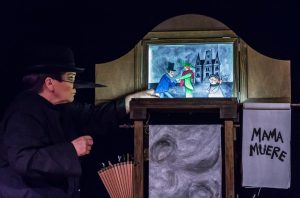 Weit entfernt von der Disney-Version von Schneewittchen erzählt unsere Geschichte das Leben einer jungen Frau, die einer blutrünstigen Stiefmutter, einer feindseligen Stadt, betrügerischen Zwergen und einem habgierigen Prinzen zum Opfer fällt. Basierend auf der 1812 veröffentlichten Originalgeschichte Märchen 53 (Das kleine Schneewittchen) der Gebrüder Grimm bietet die Geschichte von Ana Juan eine bissige, stichhaltige und auch für unsere Zeit relevante Sicht auf die Situation von Frauen. Zusammen mit der Schönheit der Puppen, Objekte und gemalten Hintergründe bietet Tale 53; Snowhite eine einzigartige theatralische Erfahrung.
Weit entfernt von der Disney-Version von Schneewittchen erzählt unsere Geschichte das Leben einer jungen Frau, die einer blutrünstigen Stiefmutter, einer feindseligen Stadt, betrügerischen Zwergen und einem habgierigen Prinzen zum Opfer fällt. Basierend auf der 1812 veröffentlichten Originalgeschichte Märchen 53 (Das kleine Schneewittchen) der Gebrüder Grimm bietet die Geschichte von Ana Juan eine bissige, stichhaltige und auch für unsere Zeit relevante Sicht auf die Situation von Frauen. Zusammen mit der Schönheit der Puppen, Objekte und gemalten Hintergründe bietet Tale 53; Snowhite eine einzigartige theatralische Erfahrung.
Puppentheater ist eine Art von Miniaturtheater, die im 19. Jahrhundert in Europa ihre Blütezeit erlebte. Die kleinen Theater, Bühnenbilder, Hintergründe und Charaktere wurden auf Papier gedruckt, angemalt und ausgeschnitten, und die Geschichten wurden in den Wohnzimmern und Salons von Privathäusern aufgeführt, oft begleitet von Live-Musik.
Hunt hat dieses Stück in Puerto Rico (San German und San Juan) und am Odin Teatret in Dänemark und New York aufgeführt. Es gehört außerdem zum Programm des Festival Internacional de Títeres (Internationales Puppenspielfestival) in Matanzas, Cuba 2018.
Tale 53; Snowhite
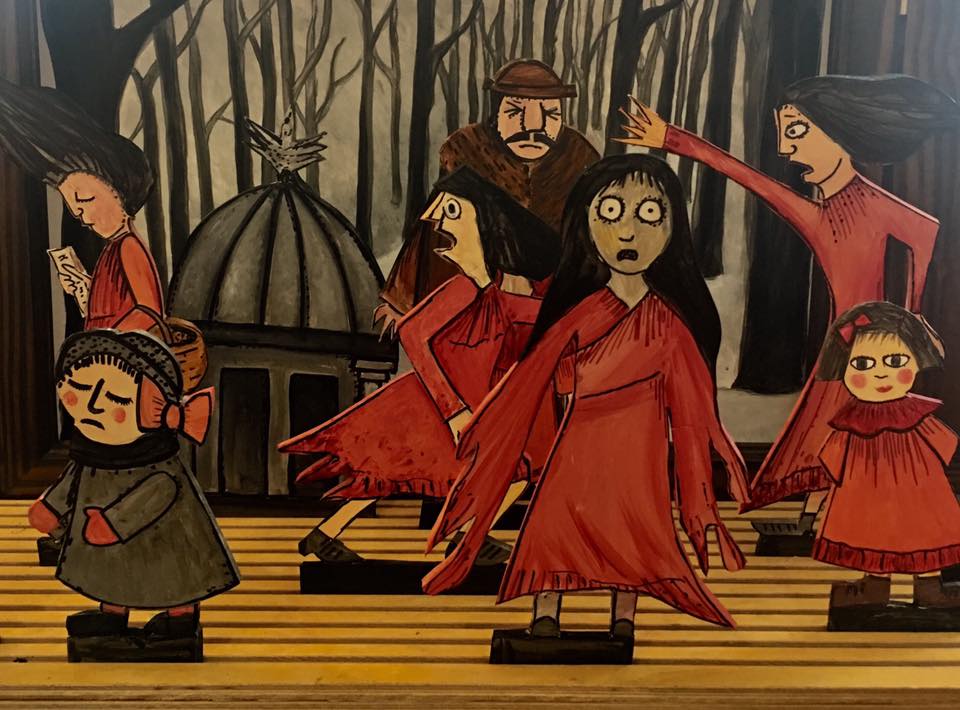 Tale 53; Snowhite is a sinister story told inside an intriguing wooden artefact that houses a toy theatre (with two-dimensional painted puppets moving on tracks), objects, a kamishibai (for backdrop changes) and a “cranky” or moving panorama. It is based on Snowhite, the creation of reknowned Spanish author and illustrator Ana Juan. Deborah Hunt has adapted and directed the tale, and manipulates the puppets and backdrops.
Tale 53; Snowhite is a sinister story told inside an intriguing wooden artefact that houses a toy theatre (with two-dimensional painted puppets moving on tracks), objects, a kamishibai (for backdrop changes) and a “cranky” or moving panorama. It is based on Snowhite, the creation of reknowned Spanish author and illustrator Ana Juan. Deborah Hunt has adapted and directed the tale, and manipulates the puppets and backdrops.
Far from the Disneyesque version of Snow White, our tale relates the life of a young woman who falls prey to a blood thirsty stepmother, a hostile city, hustling dwarves and a rapacious prince. Based on the original story Tale 53 (The Little Snow White) of the Grimm Brothers published in 1812, the story by Ana Juan offers a biting and pertinent view of the situation of women still relevant to our times. Juxtaposed with the beauty of the puppets, objects and painted backdrops, Tale 53; Snowhite promises a unique theatrical experience.
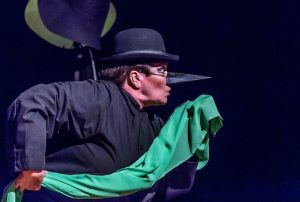
Toy theatre is a kind of theatre in miniature that flourished in the 19th century in Europe. The small theatres, scenery, backdrops and characters were printed on paper, painted and cutout and the stories were presented in the salas and drawing rooms of private houses, often accompanied with live music.
Hunt has presented the work in Puerto Rico (San German and San Juan) at the Odin Teatret in Denmark and New York. It will be presented at the Festival Internacional de Títeres de Matanzas en Cuba in 2018.
Frau Vladusch
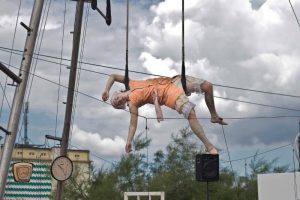
- 21.04., 19:30 HochX
Frau Vladusch lebt allein in ihrer Wohnküche, mit streng organisiertem Tagesablauf und vielen kleinen Alltagsritualen – alles einer starren Ordnung unterworfen. Ihre pedantischen Wiederholungen, Beherrschtheit und Selbstkontrolle resultieren aus Angst vor Erinnerungen und ihrer Vergangenheit: Grenzüberschreitung, Gewalterfahrung, Schmerz.
Mit Alltagsbildern und großer Liebe zu kleinen Details erzählen Erica Ruhl und Jana Korb eine sehr persönliche Geschichte. Ins Groteske auseinandergenommene Alltags-Bewegungen werden als tänzerische Elemente eingesetzt auf der Erde und in der Luft am Trapez. Artistische Tricks zerfließen zu einer Körpersprache, die den Schmerz sichtbar macht – und dennoch zum Lächeln zwingt.
Trapez-Solo an 3 Trapezen (35min.), ohne Sprache
Trapeztheater von und mit Jana Korb
Regie: Erica Ruhl
Dramaturgische Assistenz: Dieter Handler
Choreographische Assistenz: Anka Böttcher
Frau Vladusch
Frau Vladusch lives alone in her living room, with a strictly organized daily routine and many small daily life rituals – all subject to a rigid order. Their pedantic repetitions, domineering and self-control are the result of fear of memories and their past: crossing the limits, experiences of agony, pain.
With everyday pictures and great love for small details, Erica Ruhl and Jana Korb tell a very personal story. Grotesque detached daily movements are used as dance elements on the ground and in the air on the trapeze. Artistic tricks flow into a body language that makes the pain visible – and yet forces us to smile.
Trapeze solo on 3 trapezes (35 min.), without language
Trapeztheater by and with Jana Korb
Director: Erica Ruhl
Dramaturgical assistant: Dieter Handler
Choreographic assistant: Anka Böttcher
Helen Varley Jamieson
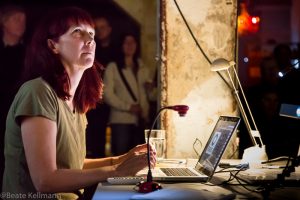
- 06.03., Feministischer Aktivismus als Performance, HochX
- 21.04., Performance: Unaussprechbarlich , HochX
- 25.04 ., Unaussprechbarlich : Meta Theater (Moosach)
Helen Varley Jamieson ist eine Schriftstellerin, Theatermacherin und digitale Künstlerin aus Neuseeland, die seit 2010 in München wohnt. Sie hat einen Master of Arts (Research) aus Queensland University of Technology (Australien), die Cyberformance (Live-Performance auf dem Internet) untersucht, und arbeitet als freischaffende Künstlerin, Forscherin und Kulturproduzentin. In ihrer künstlerischen Praxis untersucht sie Themen wie den Einfluss von Technologie auf unser Leben, Umweltbelange, Sprache, Feminismus und Kapitalismus.
Helen ist eine der Gründerinnen von UpStage, einer Künstler-geführten Open-Source-Online-Plattform für Cyberformance, und hat die Organisation von sechs Online-Festivals der Cyberformance (2007-12) geleitet. Im Jahr 2012 war sie einer der Organisatoren des CyPosium, eine Ein-Tages-Online-Symposium über Cyberformance. Nach dem sie mit Annie Abrahams Mitherausgeber “CyPosium – the book”, im Jahr 2014 veröffentlichtet hat. 2009 war sie Gastkunstlerin in der Villa Waldberta (Feldafing/München).
Helen ist eine aktive Teilnehmerin in zahlreichen Open Source und feministischen Netzwerken und seit 1999 wurde sie die “Web- Königin” für das Magdalena-Projekt. Sie war Mitglied des Organisationsteam für Magdalena Aotearoa International Festival of Women’s Performance, 1999 in Wellington, NZ und hat mehrere Magdalena Veranstaltungen in Neuseeland organisiert. Jetzt bringt sie das Magdalena-Projekt nach München.
Helen Varley Jamieson
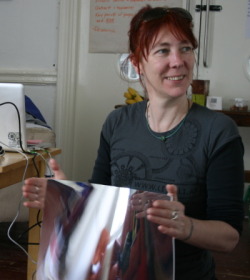 Helen Varley Jamieson is a writer, theater-maker and digital artist from New Zealand, based in Munich since 2010. She holds a Master of Arts (Research) from Queensland University of Technology (Australia), investigating her practice of cyberformance (live performance on the internet), and works as a freelance artist, researcher and cultural producer. In her artistic practice she explores themes including the impact of technology on our lives, environmental concerns, language, feminism and capitalism.
Helen Varley Jamieson is a writer, theater-maker and digital artist from New Zealand, based in Munich since 2010. She holds a Master of Arts (Research) from Queensland University of Technology (Australia), investigating her practice of cyberformance (live performance on the internet), and works as a freelance artist, researcher and cultural producer. In her artistic practice she explores themes including the impact of technology on our lives, environmental concerns, language, feminism and capitalism.
Helen is one of the founders of UpStage, an artist-led open-source online platform for cyberformance, and has collaborated in the organization of six online festivals of cyberformance (2007-12). In 2012 she was one of the organizers of the CyPosium, a one-day online symposium on cyberformance and networked performance, after which she co-edited with Annie Abraham’s CyPosium – the book, published in 2014 by LINK Editions. In 2009 she was a guest artist at Villa Waldberta (Feldafing / Munich).
Helen is an active participant in numerous open source and feminist networks and has been the “web queen” for the Magdalena Project since 1999. She was a member of the organization team for the Magdalena Aotearoa International Festival of Women’s Performance, 1999 in Wellington, NZ and has organized several Magdalena events in New Zealand. Now she is bringing the Magdalena Project to Munich.
Workshop: Kreation im begrenzten Raum
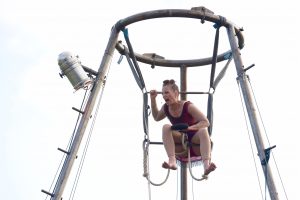
- 03-04.02., JIM e.V.
- Gebühr: €150 | Ermäßigt €90 | JIM e.V. Members €70
- Begrenzt auf 16 Teilnehmer / Limited to 16 Participants
Jana Korb kreieret luftartistische Stücke am Trapez, Luftring und Seil – Aerial Theater. Der Raum, den sie bespiele, ist in extremer Weise begrenzt und eingeschränkt. Das ist für sie zur performativen Normalität geworden. Denn genau diese Begrenztheit gibt ihr die Möglichkeit großer kreativer Freiheit und Inspiration.
Auch auf dem Boden kann dies ein wirkungsvolles performatives Mittel der Gestaltung sein – wenn man den Raum als weißes Blatt Papier begreift, wo die Entscheidung für einen Anfang schwer fällt: Stelle einen Stuhl in den Raum und verlasse diesen nicht – und es eröffnen sich kreative Welten, die weit über den Raum des Stuhls hinaus reichen.
Wir werden in diesem Workshop im unbegrenzten sowie im begrenzten Raum performen und improvisieren; wir arbeiten mit räumlichen Objekten auf dem Boden (Stühle, Tische usw.) und in der Luft.
Information für Teilnehmer/innen:
- Trainings Kleidung – lange Ärmel und Beine
- Wenn Du ein bevorzugtes räumliches Objekt hast (Stuhl, Tisch, Mülltonne, Fahrrad, Teppich…) und das mitbringen kannst, dann ist das super!
- (Luft-)artistische Vorkenntnisse sind nicht nötig
Der Workshop findet statt in der Turnhalle der Grundschule an der Jenaer Straße 3, 80992 München-Moosach – erreichbar mit der U3 Moosacher St.-Martins-Platz, Tramlinie 20 Hugo-Troendle-Str. und mit der S-Bahn S1 Moosach.
Creation in confined space
Jana Korb creates aerial performances on the trapeze, aerial ring and tissue – Aerial Theater. The space in which she works is limited and restricted in an extreme way. This has become her performative normality. But it also is precisely this limitation that allows her great creative freedom and inspiration.
Also on the ground, this can be an effective method for shaping a performance – when the space is understood as a blank sheet of paper, where the decision of how to begin is hard: place a chair in the room and never leave it – this might open up creative worlds that extend far beyond the space of your chair.
In this workshop, we will perform and improvise in unlimited and limited space; we will work with three-dimensional objects on the ground (chairs, tables, etc.) and in the air.
Information for participants:
- Training clothing – long sleeves and legs
- If you have a preferred spatial object (chair, table, rubbish bin, bicycle, carpet …) and can bring it, that’s great!
- Aerial and acrobatic skills are not required
The workshop takes place in the gymnasium of the elementary school at Jenaer Straße 3, 80992 München-Moosach. Take the U3 Moosacher St.-Martins-Platz, Tramline 20 to Hugo-Troendle-Str. or the S-Bahn S1 to Moosach.
Retazos de Piel / Hautfetzen
-
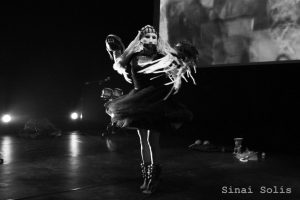 07.04., 20:00 HochX
07.04., 20:00 HochX - Spanisch, mit Deutschen Surtiteln / Spanish, with German surtitles
Hautfetzen ist eine sehr persönliche Performance von der mexikanische Künstlerin Cecilia Bolaños. Sie vermischt Episoden aus dem Leben der Künstlerin mit der Geschichte einer mythischen, weiblichen Figur der Conquista in Mexiko: Malinche, India – Sklavin – Geliebte und Übersetzerin von Hernán Cortés, sie spielte eine entscheidende Rolle bei der Eroberung des Azteken Reichs durch die Spanier. Von ihren Landsleuten verflucht und von der patriarchalischen Vision, die in unser Gesellschaften vorherrscht, in Vergessenheit gebracht, erhält sie in diesem Stück Stimme und Körper.
Doña Marina, Malinche, Malitzin, Malinalli, eine Frau, die Brücke zwischen zwei Kulturen war und mit den Klischees des Patriarchats auf beiden Seiten des Ozeans gebrochen hatte, ist nur aus der männlichen Perspektive heraus beschrieben und erzählt worden. Aus dieser Perspektive ist Malinche nur das Abbild der Unterwerfung. Obwohl sie den Erfolg der Eroberung ermöglicht hatte, war sie von Anfang an von diesem ausgeschlossen, sie wurde vollkommen unsichtbar gemacht.Ausgangspunkt ist die Verwirrung der Identität, einer Identität, die zwischen zwei oder mehr Welten, zwischen zwei oder mehr Sprachen hin und her geworfen ist.
“Viele sind davon überzeugt, dass ich eine „ganze“ Person bin, aus einem Guss, mit nur einem Gesicht, ohne Spalten und Risse. Ich aber weiß, dass ich Flickwerk bin, aus Hautfetzen, ich bestehe aus Mosaiken früherer Leben, aus einem Monster, das schon Jahrtausende in mir lebt. Ich habe es schon immer gehört, gefühlt, aber nie gesehen. Außerdem hat es sich nie herausgewagt, weder bei Tag noch bei Nacht. Aber seit ein paar Jahren steckt es immer wieder seine Köpfe heraus und gestern drängte es vollständig mit einem wütenden Brennen aus meinen Händen heraus, und hinterließ sie, bleich, trocken, tot. Man musste sie mir abnehmen und sobald sie abgeschnitten waren nisteten sich zwei seiner Köpfe auf den blutenden Gliedmaßen ein”
Dem Verständnis von Malinche eine andere Perspektive geben. In Mexiko wird sie gemeinhin als Verräterin an ihrem Volk, als Handlangerin der Spanier beim Untergang des Aztekenreichs und als Geliebte Hernán Cortes angesehen. Ich möchte sie und ihre Geschichte der “männlichen” Interpretation, der Interpretation der “Sieger” entziehen, ihre Komplexität als Person wieder finden und sie von den Mythen befreien, um meine Geschichte zu verstehen, als Tochter dieser ersten Mutter, von der alle Mestizen in Mexiko, in Amerika abstammen. Diese Mutter steht als Metapher für einen vergewaltigen und als Kriegsbeute betrachteten Kontinent. Und so eine Identität gewinnen.
Mit freundliche Unterstützung des Migrationsbeirats.
Shreds of Skin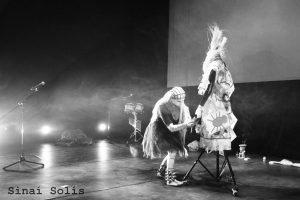
Shreds of Skin is a very personal performance from the Mexcian artist Cecilia Bolaños. It combines episodes from her life with the story of a mythical female figure from the conquest of Mexico: Malinche, the Indian – a slave – and the lover and translator of Hernán Cortés, who played a pivotal role in the Spanish conquest of the Aztec empire. Cursed by her compatriots and forgotten by the patriarchal vision that prevails in our society, she receives voice and body through this performance.
Doña Marina, Malinche, Malitzin, Malinalli, a woman who was the bridge between two cultures and who broke with the stereotypes of patriarchy on both sides of the ocean, has been described and narrated only from a male perspective. From this perspective, Malinche is only the image of submission. Although she made the success of the conquest possible, she was excluded from the start, made completely invisible. The point of departure for this performance is the confusion of identity, an identity thrown back and forth between two or more worlds, between two or more languages.
“Many are convinced that I’m a “whole” person, all in one piece, with just one face, no cracks or gaps. But I know that I am a patchwork, made of hideous scraps. I am a mosaic of the past lives of a monster that has lived in me for millennia. I have always heard it, felt it, but never seen it. Moreover, it never ventured out, either by day or by night. But for a couple of years it has begun to poke out its heads, and yesterday, it pushed out completely with a furious burning from my hands, leaving them pale, dry, dead. They had to be removed and as soon as they were cut off, two of the heads nested on the bleeding limbs.”
Malinche can be understood from a different perspective. In Mexico, she is commonly regarded as a traitor to her people, a collaborator with the Spaniards in the fall of the Aztec empire and a lover of Hernán Cortes. Cecilia Bolaños reclaims Malinche and her story from the male interpretation, the interpretation of the “victors”. She rediscovers Malinche’s complexity as a person and rids her of the myths in order to understand her own story as a daughter of this first mother, from whom all the Mestizos in Mexico are descended. This mother stands as a metaphor for a rape-ridden continent, considered as war booty. Through the performance she finds an identity.
